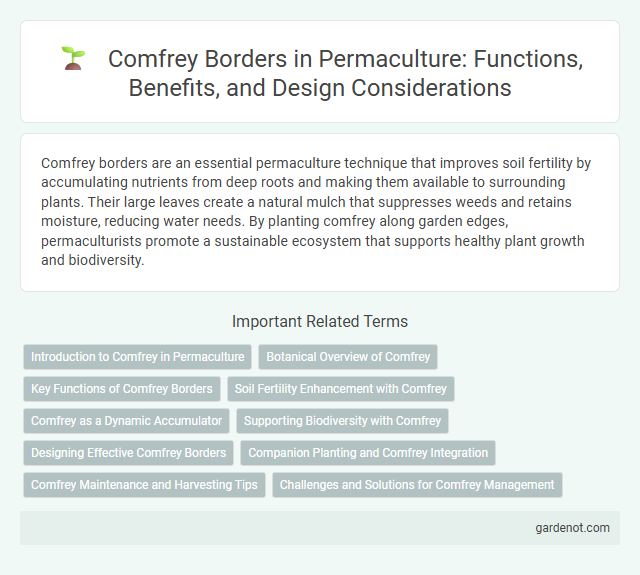Comfrey borders are an essential permaculture technique that improves soil fertility by accumulating nutrients from deep roots and making them available to surrounding plants. Their large leaves create a natural mulch that suppresses weeds and retains moisture, reducing water needs. By planting comfrey along garden edges, permaculturists promote a sustainable ecosystem that supports healthy plant growth and biodiversity.
Introduction to Comfrey in Permaculture
Comfrey is a fast-growing perennial herb valued in permaculture for its deep roots that mine nutrients and improve soil structure. It serves as a dynamic accumulator, drawing essential minerals like potassium and phosphorus to the surface, enhancing fertility for surrounding plants. Integrating comfrey borders stimulates natural mulch production and provides potent biomass for compost and liquid fertilizers.
Botanical Overview of Comfrey
Comfrey (Symphytum officinale) is a fast-growing, herbaceous perennial renowned for its large, hairy leaves and bell-shaped, purple to pink flowers that bloom from late spring to early summer. This nutrient-dense plant thrives in moist, well-drained soils and is commonly used in permaculture for its deep roots that draw up minerals, improving soil fertility naturally. Comfrey's ability to accumulate potassium, calcium, and nitrogen makes it an excellent dynamic accumulator and companion plant in sustainable garden systems.
Key Functions of Comfrey Borders
Comfrey borders act as dynamic nutrient accumulators, efficiently mining potassium and other minerals from deep soil layers, which enriches the surrounding plants when cut and mulched. Their dense foliage provides excellent weed suppression and soil moisture retention, creating a favorable microclimate along garden edges. Furthermore, comfrey flowers attract pollinators and beneficial insects, enhancing biodiversity and natural pest control within permaculture systems.
Soil Fertility Enhancement with Comfrey
Comfrey borders enhance soil fertility through deep roots that mine essential nutrients like potassium, calcium, and phosphorus from subsoil layers, bringing them to the surface where they become accessible to other plants. The plant's abundant biomass can be harvested and used as mulch or compost activator, enriching the soil with organic matter and stimulating microbial activity. Regular incorporation of comfrey leaves accelerates nutrient cycling, improves soil structure, and supports a healthy, fertile growing environment in permaculture systems.
Comfrey as a Dynamic Accumulator
Comfrey acts as a powerful dynamic accumulator by mining deep soil nutrients such as potassium, calcium, and phosphorus and concentrating them in its leaves. When used as a border in permaculture gardens, its nutrient-rich foliage can be harvested and applied as mulch or compost, enriching the soil naturally. This process enhances soil fertility, promotes healthy plant growth, and supports sustainable gardening practices.
Supporting Biodiversity with Comfrey
Comfrey borders enhance biodiversity by attracting pollinators such as bees and butterflies, essential for a healthy ecosystem. The deep roots of comfrey improve soil structure and nutrient cycling, supporting diverse plant and microbial life. Its dense foliage provides habitat and shelter for beneficial insects, boosting overall garden resilience and productivity.
Designing Effective Comfrey Borders
Designing effective comfrey borders involves strategic placement to maximize soil enrichment and pest control benefits within permaculture gardens. Plant comfrey along garden edges where its deep roots extract nutrients and improve soil fertility while its dense foliage suppresses weeds, enhancing plant health. Regular harvesting of comfrey leaves provides a sustainable mulch or compost activator, promoting a self-sufficient ecosystem.
Companion Planting and Comfrey Integration
Comfrey borders enhance companion planting by improving soil fertility through nutrient accumulation and deep root mineral mining, benefiting neighboring plants like fruit trees, brassicas, and herbs. Integrating comfrey into garden systems supports pest control by attracting pollinators and beneficial insects while suppressing weeds with its dense foliage. Its dynamic nutrient cycling and mulch production optimize plant growth, making comfrey an essential component in sustainable permaculture designs.
Comfrey Maintenance and Harvesting Tips
Comfrey requires regular maintenance to promote healthy growth and nutrient accumulation, including consistent watering during dry spells and periodic pruning to prevent woody stems. Harvest leaves before flowering for optimal nutrient content, typically cutting 2-3 times per growing season, ensuring not to remove more than two-thirds of the plant at once to avoid stress. Use sharp tools to make clean cuts and recycle trimmed foliage as nutrient-rich mulch or compost activator within the permaculture system.
Challenges and Solutions for Comfrey Management
Comfrey borders often face challenges such as aggressive spreading and nutrient depletion in adjacent plants due to comfrey's deep-root system and high nitrogen uptake. Effective management includes regular harvesting to control growth and prevent invasiveness, alongside strategic placement with buffer plants that tolerate nutrient competition. Implementing root barriers or periodic soil testing can also mitigate negative impacts, ensuring balanced soil health and coexistence with surrounding vegetation.
Comfrey border Infographic

 gardenot.com
gardenot.com